God of War Ragnarök has finally made its way to PC after being a PlayStation exclusive for two years. While it’s technically an older game, it still looks amazing on PC, plays incredibly well, and incorporates several new technologies such as DLSS 3, FSR 3.1, XeSS 1.3 upscaling, and both FSR and DLSS frame generation.
The game is built on an unnamed engine developed by Santa Monica Studio, which has worked on the God of War series since 2005. Of course, the engine has been updated for Ragnarök, supporting the upscaling features mentioned earlier, along with required DX12 support. However, there is no ray tracing, which we’re sure very few will be disappointed to hear, as the game still looks great and plays even better.
This means you’ll be able to enjoy God of War Ragnarök in all its glory with surprisingly modest hardware – unlike many of the AAA games we’ve looked at this year. Still, if you’re in need of an upgrade, the data in this video will help you figure out exactly what you need to achieve your desired frame rate.
Click the image below for a God of War Ragnarök PC gameplay walkthrough (4K 60FPS):

For testing, we’re using one of the most demanding sections of the game, found after nearly four hours of gameplay. Since God of War Ragnarök was initially a PS4 and PS5 exclusive, it’s designed with very modest CPU requirements, so you’ll likely see minimal CPU usage on PC, assuming you have a Zen 3 CPU or newer.
Realistically, you’re going to end up 100% GPU-limited in this title. There are some larger open-world sections, but they’re sparsely populated, again due to CPU constraints on older consoles.

For testing, we’re looking at 1080p, 1440p, and 4K resolutions using the ‘Ultra’, ‘High’, and ‘Medium’ presets. It’s worth noting that you can change these presets on the fly, and most changes seem to apply immediately. However, we found that a full game reset is required to enable all settings, as there is a slight change in FPS performance.
It’s always best practice to reset games between quality setting changes, so we’ve done this for all our testing. Thankfully, God of War Ragnarök is a very quick game to exit and reload.
Test Setup
| CPU | AMD Ryzen 7 7800X3D |
| Cooling | be quiet! Pure Loop 2 FX 360mm |
| Motherboard | Gigabyte X670E Aorus Master [BIOS F33b] |
| Memory | G.Skill Trident Z5 RGB 32GB DDR5-6000 [CL30-38-38-96] |
| ATX Case | MSI Prospect 700R |
| Power Supply | Kolink Regulator Gold ATX 3.0 1200W |
| Storage | TeamGroup T-Force Cardea A440 M.2 PCle 4 NVMe SSD 4TB |
| Operating System | Windows 11 |
| Display Driver | Nvidia Game Ready Driver 561.09 |
| AMD Adrenalin Edition 24.20.11.01 | |
| Intel Arc 32.0.101.6078 |
Finally, for testing the GeForce GPUs, we’re using Game Ready Driver 561.09, and for the Radeon GPUs, Adrenalin Edition 24.20.11.01. Please note that we also tried the official 24.8.1 driver and found that performance remained the same. We’ve also included the Intel Arc A770, using driver version 32.0.101.6078. Now, let’s get into the data…
Benchmarks
Ultra Quality 1080p Native
Starting with the 1080p Ultra results, we find that the RTX 4090 achieves 159 fps at native 1080p, which is impressive, especially considering how good the game looks. The RTX 4080 and 4080 Super reached 134 fps, which is considerably faster than the Radeon RX 7900 XTX, trailing by 13%. In fact, the flagship Radeon GPU only managed to match the RTX 4070 Ti Super, placing the 7900 XT down alongside the 4070 Super, just slightly ahead of the older RTX 3080.

The 7900 GRE matched the RTX 4080 with 87 fps. For 60 fps, you’ll only need a 7700 XT or 3060 Ti, while the 4060 Ti was a little faster. For those satisfied with around 45 fps, the older Radeon RX 6600 XT will suffice, though we’d recommend lowering the quality settings to hit 60 fps or higher.
Ultra Quality 1440p Native
At 1440p, the increased GPU load benefits the Radeon cards, with the 7900 XTX now only 9% slower than the RTX 4080 and 6% faster than the 4070 Ti Super. The 7900 XT stepped up to match the RTX 3090, now performing on par with the 4070 Super.
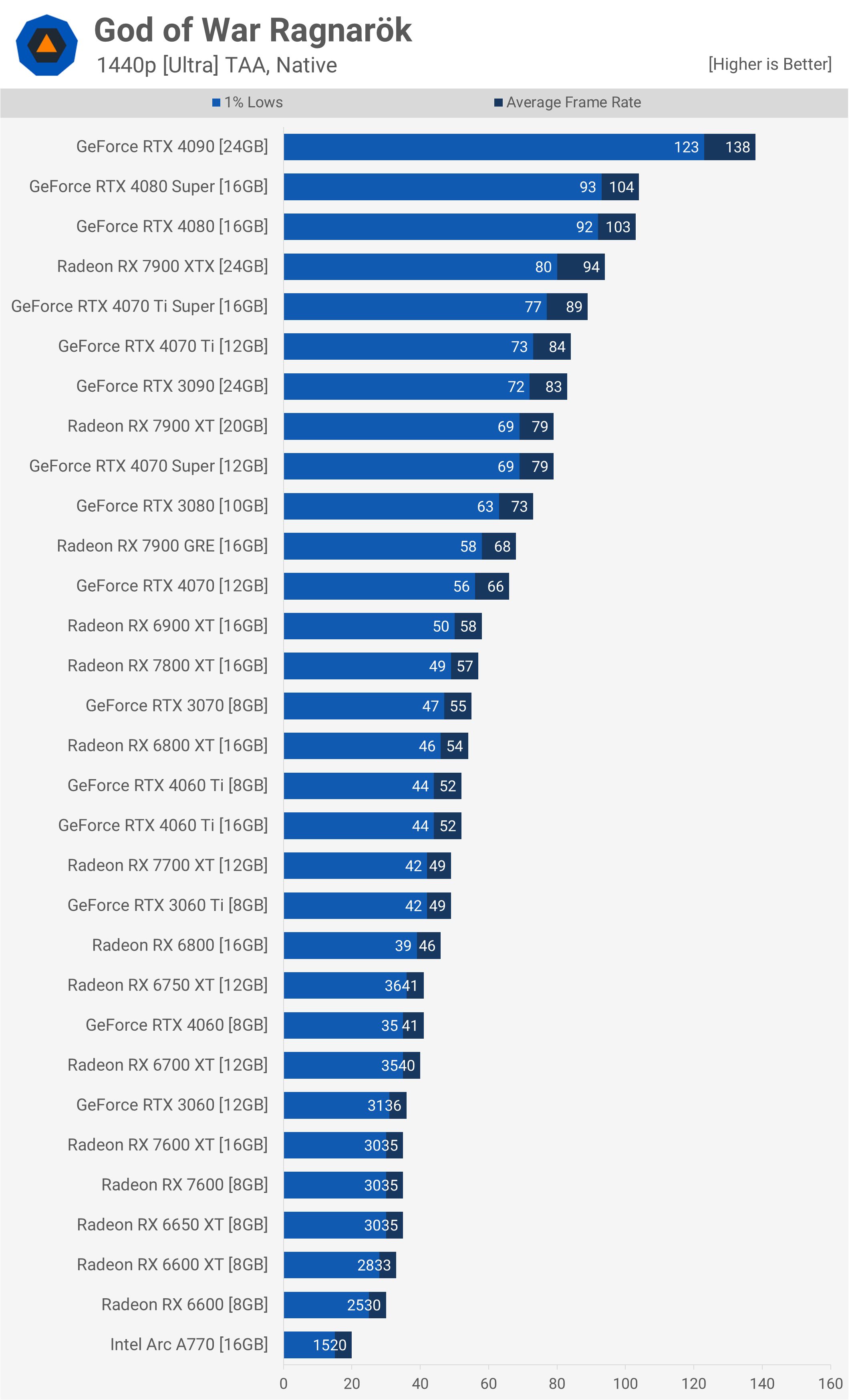
For over 60 fps, you’ll need at least a 7900 GRE or RTX 4070. Beyond that, fps drops below 60, though the 7700 XT closes in on the 4060 Ti. It’s worth mentioning that, in our short benchmark pass, the 8GB and 16GB versions of the 4060 Ti delivered the same results. However, we can’t guarantee this will hold true for extended gameplay, which we’ll look into further.
Ultra Quality 2160p Native
For those wanting to play God of War Ragnarök at native 4K with max settings, you’ll need a powerful GPU, as even the RTX 4090 couldn’t hit 100 fps in our tests. The 7900 XTX averaged 71 fps, enough to roughly match the RTX 4080 and 4080 Super.

Hitting 60 fps required the 4070 Ti Super, while the 7900 XT and 4070 Ti fell just short. However, some upscaling would bring them to 60 fps, which we’ll explore soon.
High Quality 1080p Native
Dropping the visual preset from Ultra to High improves performance by 10-15%, depending on the GPU. The good news is that at 1080p, most GPUs can render 60 fps. From AMD, the Radeon RX 6750 XT achieved this, while from Nvidia, the RTX 4060 was sufficient. AMD’s latest entry-level RX 7600 was underwhelming, delivering just 52 fps – similar to the 6600 XT.

High Quality 1440p Native
At 1440p, the 6800 XT and RTX 3070 are needed for 60 fps. Among current-gen cards, the 7800 XT managed 64 fps, while the RTX 4070 delivered a more impressive 75 fps. The 7900 XT and 4070 Super reached around 90 fps, while the 7900 XTX landed between the 4070 Ti Super and RTX 4080 with 106 fps.
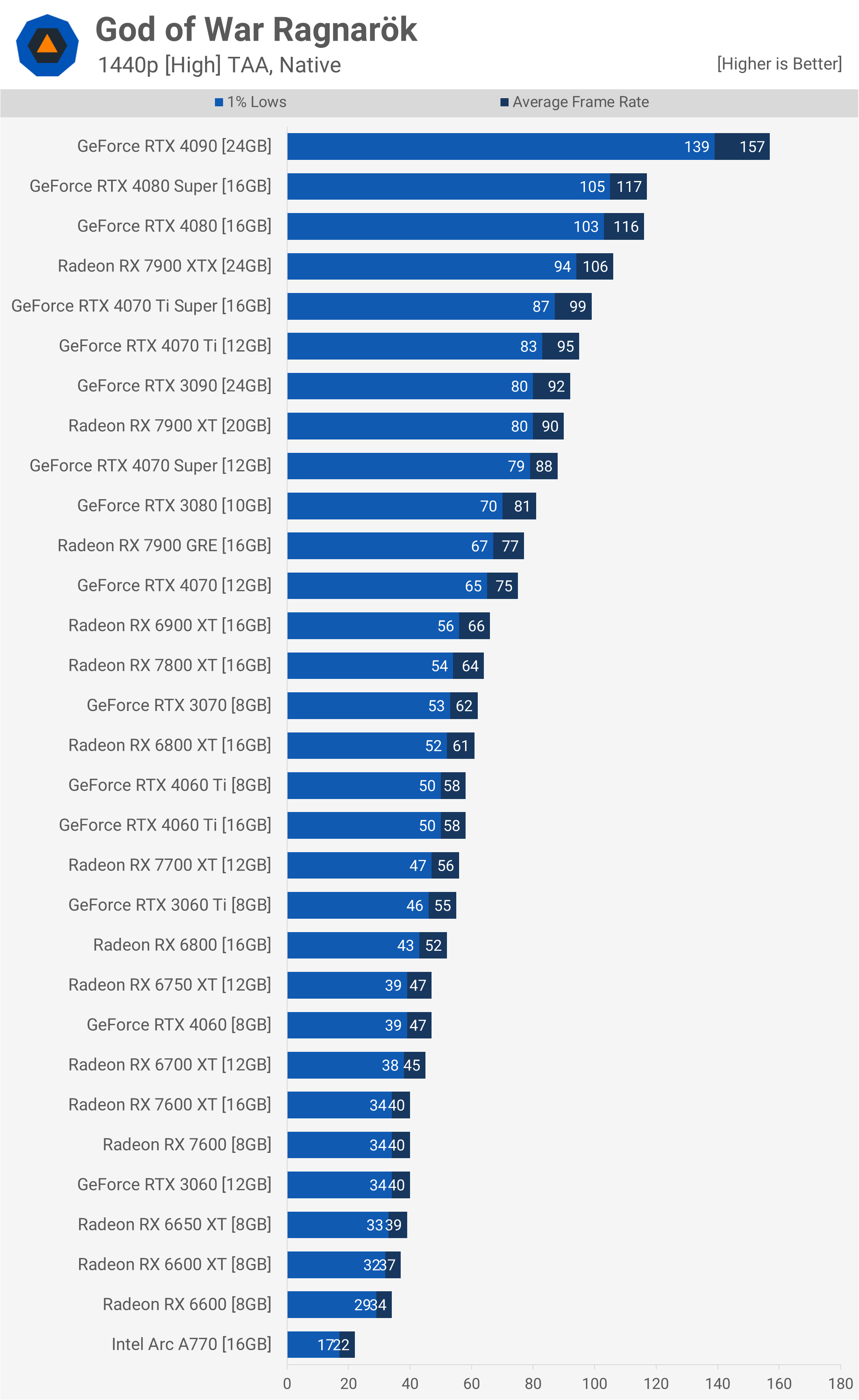
High Quality 2160p Native
At 4K, the game remains very demanding, but most high-end GPUs deliver excellent performance. The 4070 Super, for example, managed 60 fps, and enabling DLSS upscaling can further boost performance. The 7900 XT was right there with 63 fps, while the 7900 XTX matched the RTX 4080 and 4080 Super. Meanwhile, the RTX 4090 stood out with an impressive 110 fps.

Medium Quality 1080p Native
Using the Medium preset, you can expect a 15-20% performance boost from High, or a massive 30-35% increase from Ultra. As a result, the RTX 4090 is now pushing over 200 fps at 1080p, and nearly every GPU tested can render at least 60 fps on average. The only exceptions are the 6600 XT, RX 6600, and Arc A770. Everything else ran smoothly, and the game still looks quite good.

Medium Quality 1440p Native
At 1440p, we’re still seeing great performance from most GPUs. For those content with 60 fps, the RX 6800, RTX 3060 Ti, 7700 XT, or 4060 Ti will do the job. For a smoother 80-90 fps experience, you’ll need an RTX 4070 or 7900 GRE. To push beyond 100 fps, the 4070 Super and 7900 XT performed well.

Medium Quality 2160p Native
Finally, at 4K using the Medium preset, it’s possible to exceed 100 fps with the RTX 4090. The 4070 Ti hit 81 fps, the 4070 Ti Super reached 82 fps, and the 7900 XTX came close to 90 fps, just a few frames behind the RTX 4080. Once again, Radeon GPUs are most competitive at 4K in this title, which is a bit unusual.

1080p Preset Scaling
Now, here’s a look at preset scaling at 1080p using the RTX 4070 Super and 7900 XT. Once again, the Radeon GPU doesn’t scale very well at 1080p, particularly with the low-quality preset. Oddly, while the 4070 Super saw a massive 30% uplift when dialing down from medium to low, the 7900 XT only experienced a 6% increase. Aside from that, performance and scaling between these two GPUs were very similar using the medium, high, and ultra presets at 1080p.

1440p Preset Scaling
At 1440p, we observe more consistent scaling from the 7900 XT, and again, both GPUs are closely matched. We’re seeing around a 14% increase when moving from ultra to high, followed by an 18% uplift with medium, and a 21% increase for the 7900 XT when going from medium to low. Meanwhile, the 4070 Super achieved a much larger 32% increase in the same range.
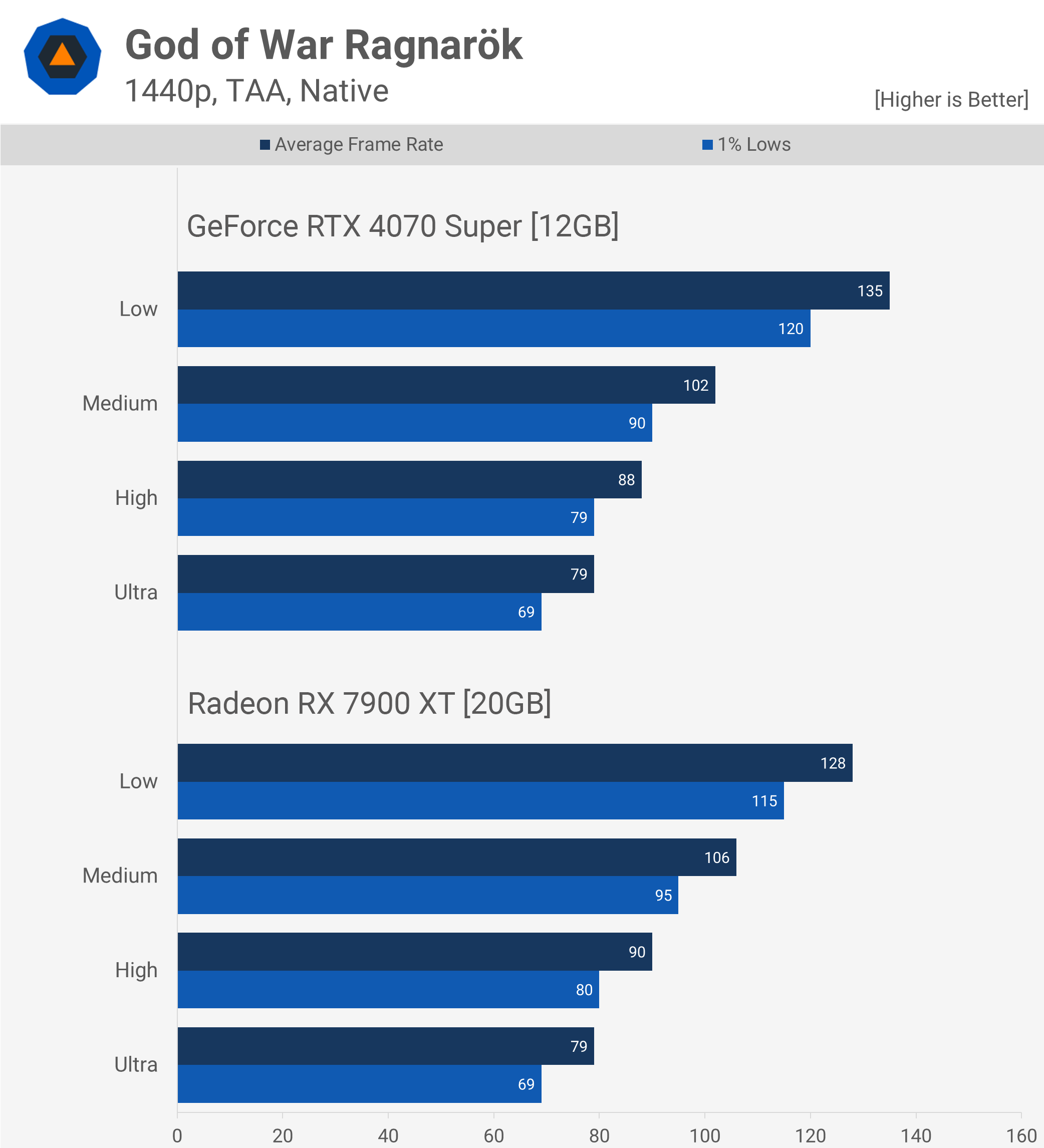
2160p Preset Scaling
At 4K, scaling is very similar between the 7900 XT and 4070 Super. We’re looking at an 11-13% improvement when moving from ultra to high, 15-16% from high to medium, and a 21-26% uplift when dropping from medium to low.
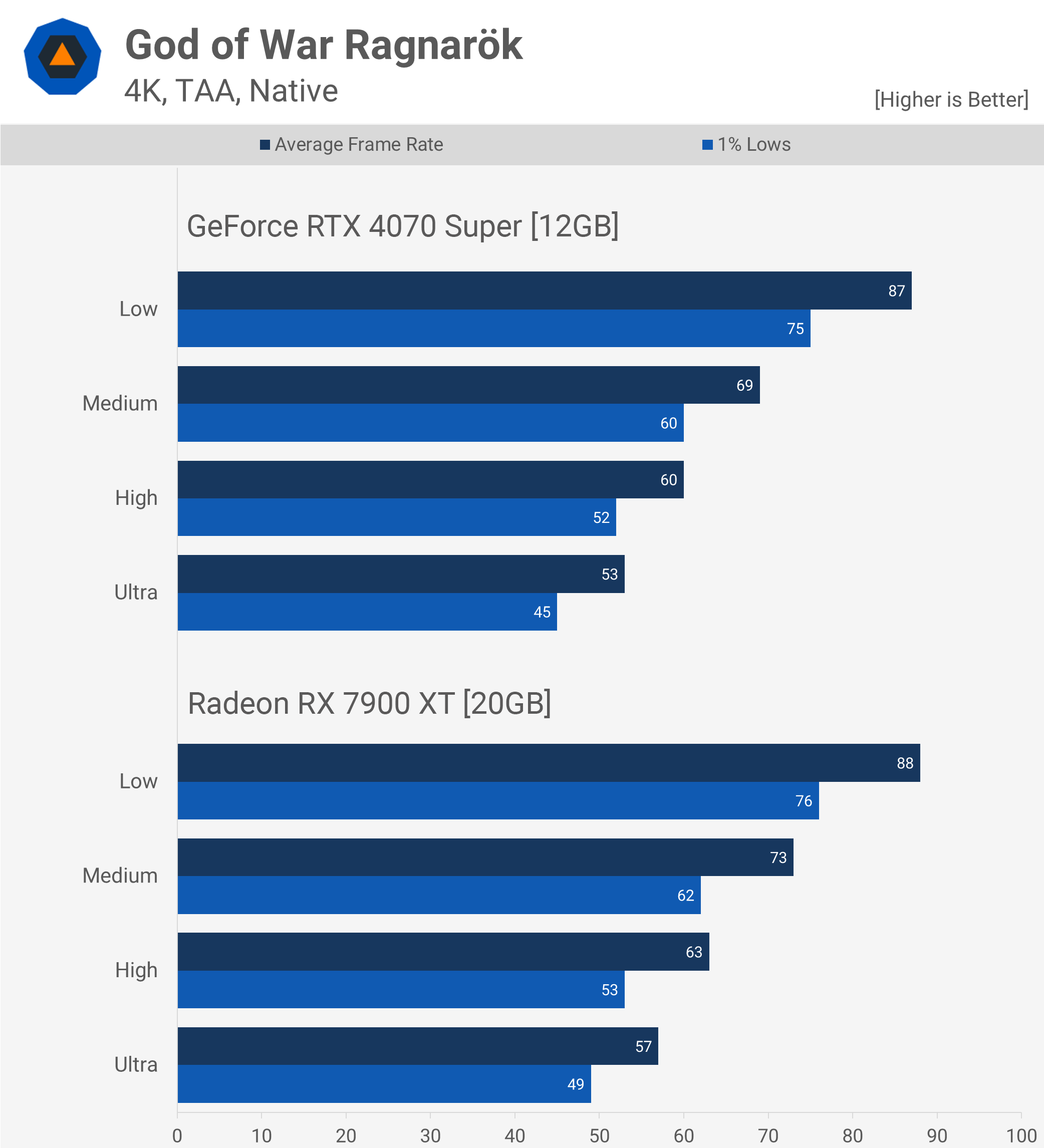
1080p Upscaling
Lastly, let’s examine upscaling performance. For all the testing so far, we’ve stuck with temporal anti-aliasing (TAA) to provide apples-to-apples comparisons. As shown, TAA is noticeably faster than DLSS when running at native resolution. With DLAA, you’re looking at around a 16% greater performance with TAA. Using the ultra preset, we found a 32% performance improvement with quality upscaling enabled, though that translates to just a 14% uplift compared to the native TAA result.

With the low preset, we saw only a 15% uplift with quality DLSS enabled at 1080p, which is 9% faster than native TAA.
For the 7900 XT, TAA outperformed FSR by 12% using the ultra preset at native resolution. FSR quality upscaling boosted performance by 27%, but that’s only a 13% improvement over native TAA. At the low preset, we encountered an odd 140 fps limit with the Radeon GPU, so we’re not entirely sure what’s going on there – likely something a future driver update will address.
1440p Upscaling
At 1440p, the performance gap between FSR and DLSS compared to TAA narrows, with TAA now just 5-7% faster. We also observed around a 25% boost with quality upscaling enabled, at least with the ultra-quality preset. Again, the 7900 XT hit the 140 fps limit with FSR upscaling.
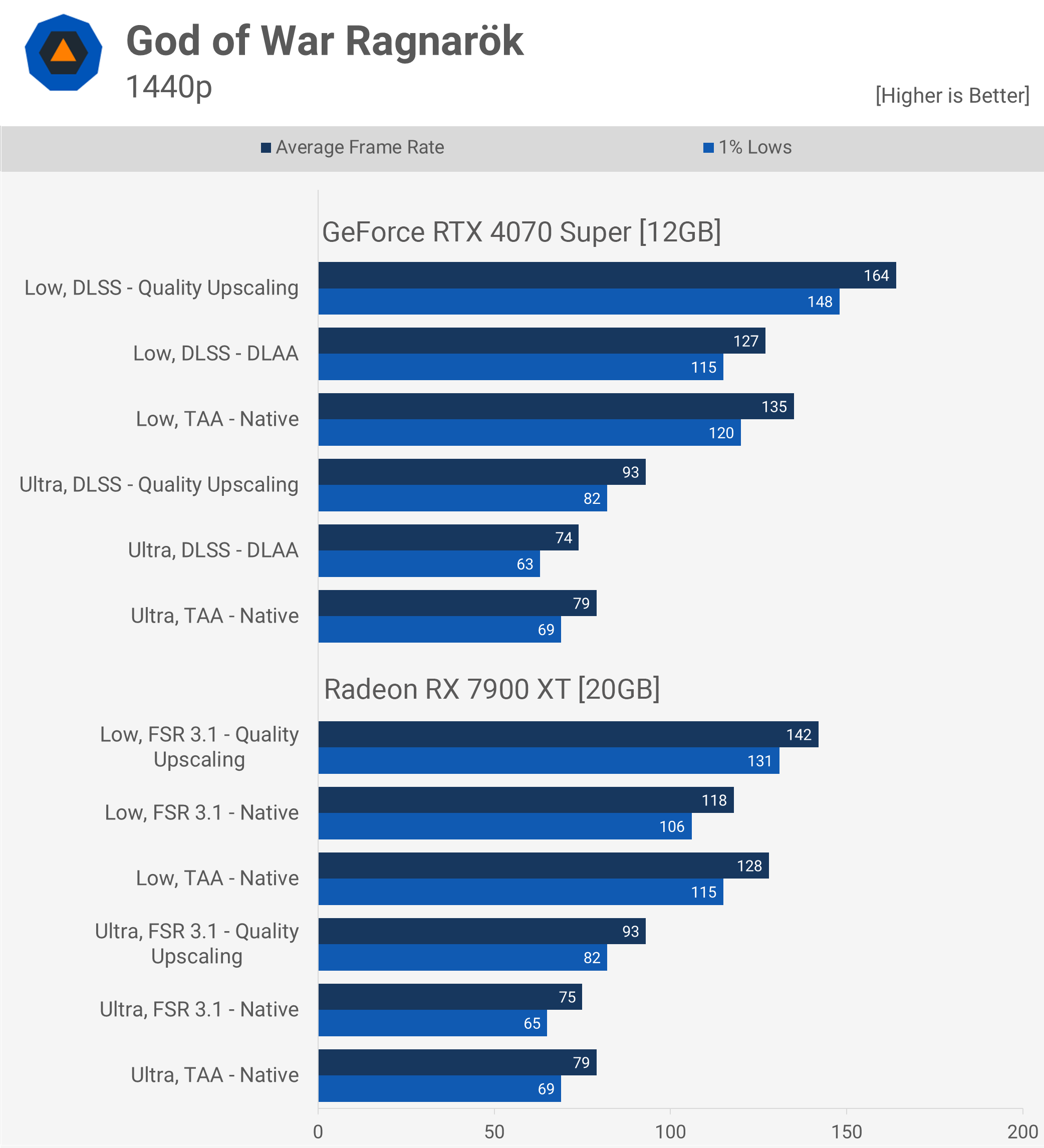
2160p Upscaling
Finally, at 4K, the performance difference between DLSS/FSR and TAA is around 6-10%. In the case of the 4070 Super, we found a 38% uplift with quality upscaling enabled, while the 7900 XT saw a 37% uplift. Margins increased slightly, reaching 41-44% when using the low preset.

What We Learned
So, there you have it – a great-looking game that actually performs well on modest hardware. To be fair to some of the other games we’ve tested, there isn’t always much going on in God of War Ragnarök. In that sense, it’s a relatively straightforward game; you don’t encounter NPC-heavy, open-world environments like in Cyberpunk, for example. However, it’s still a well-designed game that looks great and plays very smoothly.
The fact that you can play at native 1440p using the maximum in-game quality preset and still achieve well over 60 fps on an RTX 4070 or 7900 GRE is impressive, especially considering we tested one of the most demanding sections of the game after more than three hours of gameplay.
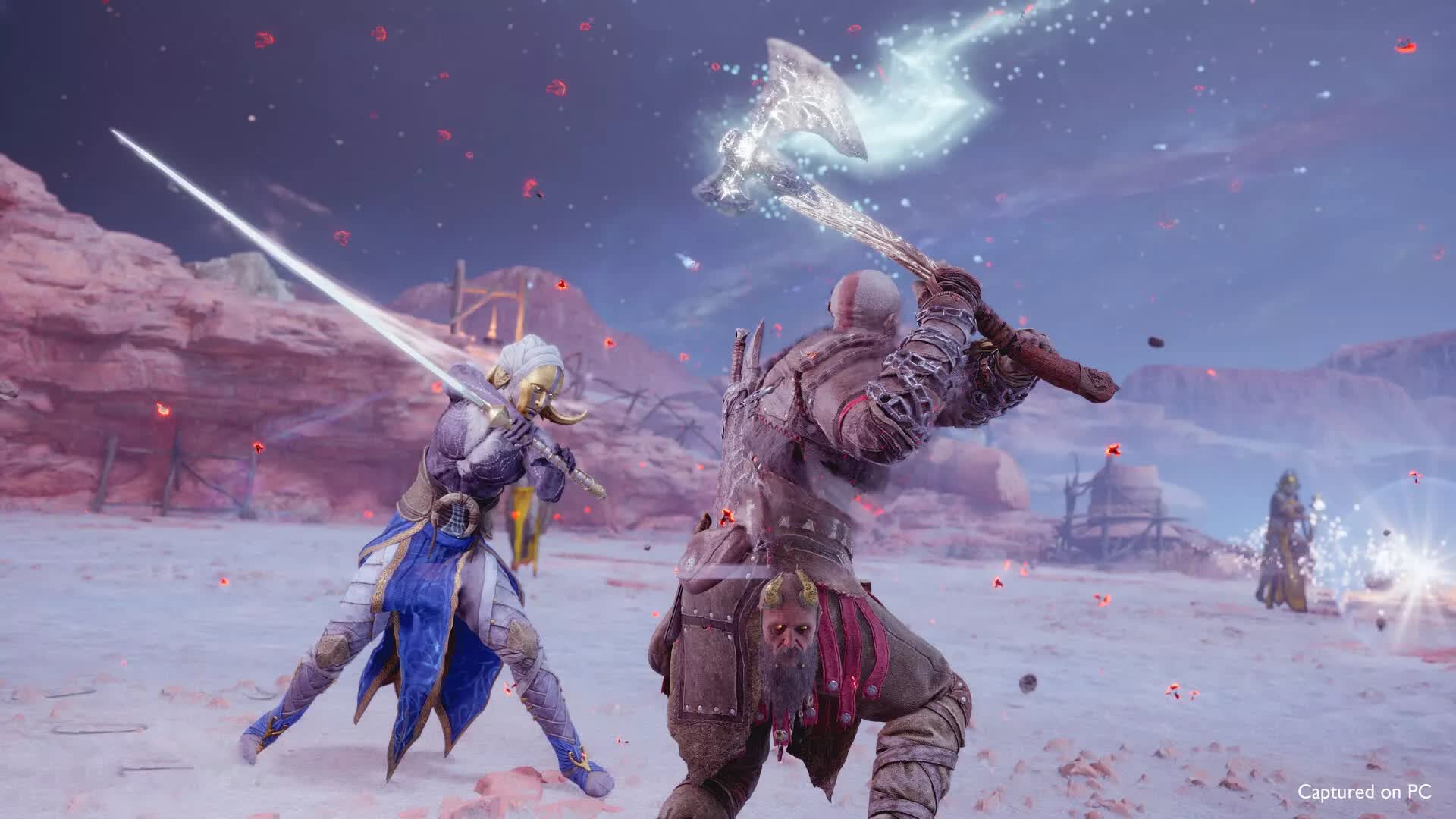
If you’re content with the medium preset, which still looks very good in our opinion, hitting 60 fps becomes easy with a GPU like the RTX 3060 Ti or RX 6800. You can also enable quality upscaling for about a 30% performance boost, which should get you to around 80 fps.
As we mentioned earlier, this game isn’t CPU-intensive, largely due to the limited number of NPCs. However, it does take up a significant amount of disk space, with the install on our test system weighing in at a hefty 175 GB, which seems a bit excessive. That said, we agree with the choice here.
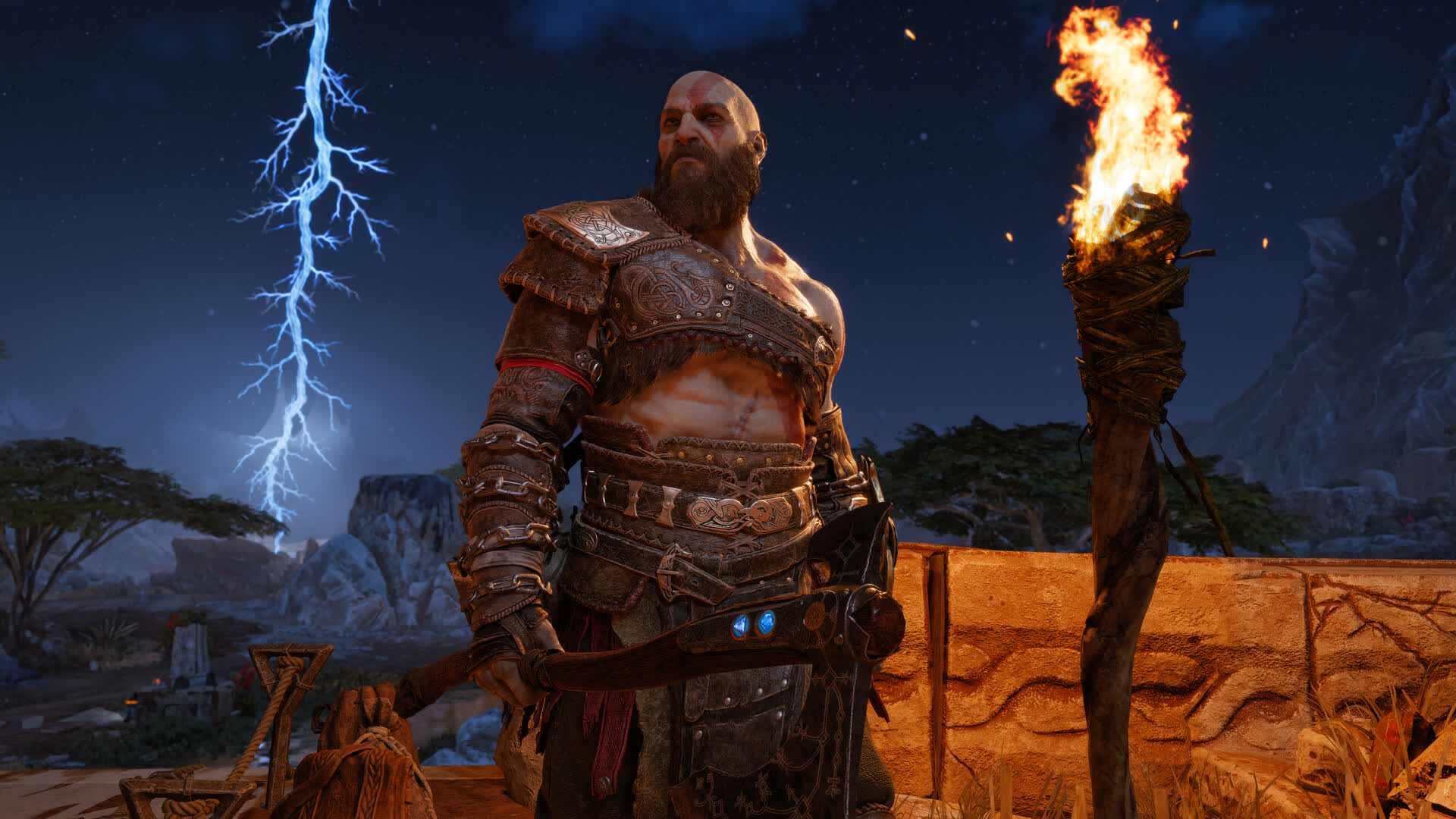
Had the developer compressed the game more heavily, the experience wouldn’t be as seamless, likely suffering from decompression stalls that result in annoying frame stutters. Keep in mind, though, you don’t need to download the full 175 GB; the download size is still large at 100 GB, but we’re fine with this trade-off. Storage space is relatively affordable now, and you don’t have to keep the game installed forever. Once you’re done, you can move it to a cheaper hard drive, or if internet speed and bandwidth aren’t an issue, simply delete it.
While a 175 GB game install might seem crazy to some, it’s important to remember that heavy decompression can lead to in-game stuttering, long load times, or even stability issues. It’s a trade-off, but one we think is worth making.

As for VRAM usage, the game is quite reasonable. Texture quality isn’t amazing, but it’s still very good. We’ve seen VRAM usage go above 9 GB at 1440p, though we haven’t yet had a chance to conduct extensive 8GB vs. 16GB testing. Also, be aware that 6GB is the minimum VRAM spec for this game. A recent patch allows you to attempt playing on 4GB cards, though the developer warns of poor performance and potential crashes.
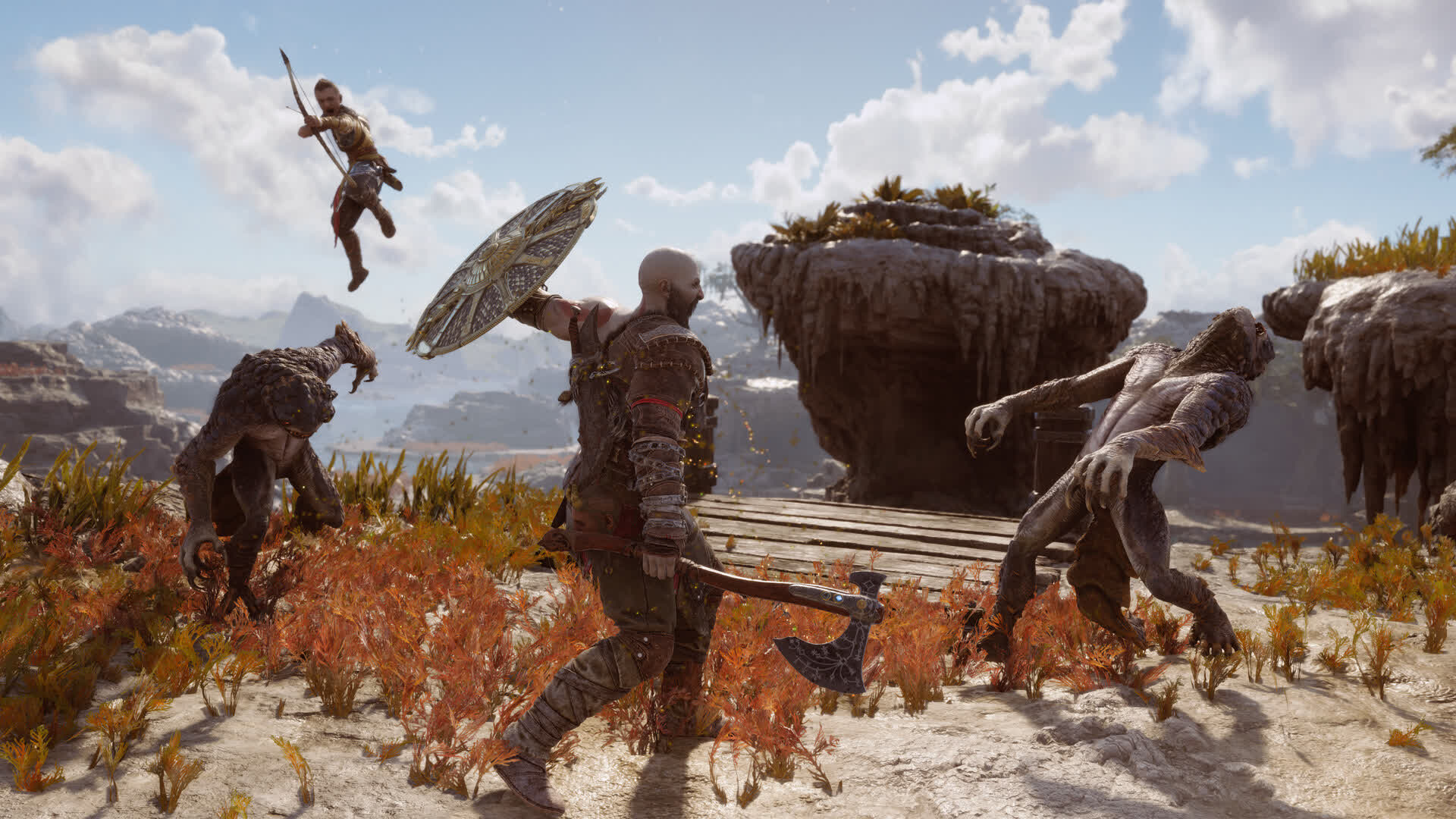
Features like DLSS frame generation will require more VRAM, so it likely won’t work well on 8GB cards using ultra-quality settings, but we’ll need to explore this further in future content. DLSS frame generation was broken when the game first launched, but Patch 2 fixed the issue, so it should be working now.
All in all, it’s great to see another exciting, high-quality game land on PC this year, especially one that you can enjoy on previous-generation hardware.
Shopping Shortcuts:
- Nvidia GeForce RTX 4070 Ti Super on Amazon
- Nvidia GeForce RTX 4080 Super on Amazon
- Nvidia GeForce RTX 4090 on Amazon
- Nvidia GeForce RTX 4070 Super on Amazon
- AMD Radeon RX 7800 XT on Amazon
- AMD Radeon RX 7900 XT on Amazon
- AMD Radeon RX 7900 XTX on Amazon
